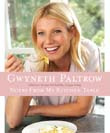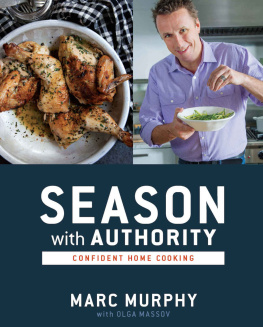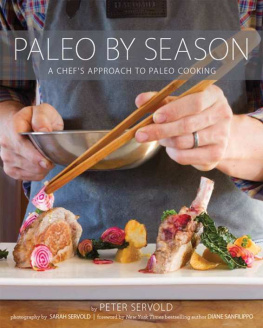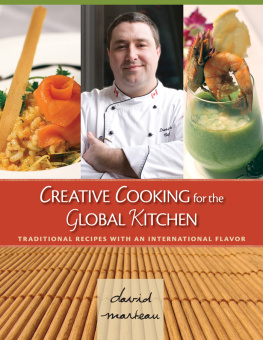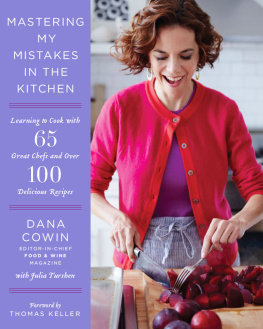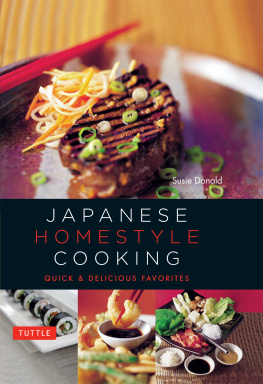


salt to taste
T HE K EY TO C ONFIDENT , D ELICIOUS C OOKING

MARCO CANORA
with Catherine Young
Photographs by John Kernick
Foreword by Tom Colicchio

Mention of specific companies, organizations, or authorities in this book does not imply endorsement by the author or publisher, nor does mention of specific companies, organizations, or authorities imply that they endorse this book, its author, or the publisher.
Internet addresses and telephone numbers given in this book were accurate at the time it went to press.
2009 by Marco Canora
Photographs copyright 2009 by John Kernick
All rights reserved. No part of this publication may be reproduced or transmitted in any form or by any means, electronic or mechanical, including photocopying, recording, or any other information storage and retrieval system, without the written permission of the publisher.
Book design by Christina Gaugler
Library of Congress Cataloging-in-Publication Data
Canora, Marco.
Salt to taste : the key to confident, delicious cooking / Marco Canora with Catherine Young.
p. cm.
ISBN-13 9781594867804 hardcover
ISBN-10 1594867801 hardcover
eISBN-13 9781605293219
1. Cookery, Italian. 2. Salt. I. Young, Catherine. II. Title.
TX723.C28324 2009
641.9545dc22
2009020051

We inspire and enable people to improve their lives and the world around them
For more of our products visit rodalestore.com
To my wife, Amanda; my daughter, Stella; my mom, Laura; and my aunt, Leda

contents
foreword
when Marco arrived at Gramercy Tavern in the winter of 1996, he had a long ponytail down his back, a scanty resume, and good hands, which is chef shorthand for the knack, the touch, whatever you want to call it. I could see by the way he worked with food that he had that indefinable something all great cooks need in order to go places.
He also had the kind of passion for the craft that cant be taughtyou either have it or you dont. I remember Marcos first few weeks on the line: He would trot down to the pass at every opportunity to watch as food was plated and then scurry back to his pans without missing a beat. He wasnt just talented, he was curious, an unbeatable combination.
Marco told us about how hed grown up cooking with his mother and aunt from a time before memory. The ease and pleasure with which those two fine Tuscan cooks met each meal had made its way deep into his consciousness, and soon Marco was my sous chef, running a tight ship and thinking on his feet. It was a measure of Marcos worth to me that I released him each summer to chef at his mothers excellent trattoria on Marthas Vineyard. I wanted him to get used to running his own kitchen for selfish reasonsthe idea for a new restaurant was percolating, and I knew Marco could be invaluable there as chef de cuisine.
Marco spoke longingly of Italy and his desire to learn at Fabio Picchis famous Cibro, known for its inventive take on ancient Florentine cuisine. Happily, we had a connection there and were able to send him for a stage in 1998. Marco came back from Florence transformed in a subtle but important way; whereas the cooking at Gramercy Tavern derived from the French techniquesstocks, sauces, butterCibro brought Marco back to his Tuscan rootsvegetables, olive oil, soffritto.
At Cibro, the lessons Marco learned in his mothers kitchen were cemented and refined. For the restaurant that was to become Craft, I was hankering for simple roasts and clearer flavors, and Marco understood instinctively what I meant; whereas most chefs would have been afraid of simplicity, Marco embraced it. Food that preciseuncomplicated, yet complexrequired a chef of the highest confidence and skill, which he was.
Cooking for many chefs is a job. But for Marco, cooking is a lifestyle. He cooks at home, much to the enjoyment of family and their wide circle of friends. This book reflects that multidimensionalityby nature, cooking at home is different than that done in a restaurant, but it comes from the same place: true passion, knowledge and love of fine ingredients, and a conviction that one should do only as much to a dish as it needs to be great, never more. Marco Canora cooks with his heart and soul. He cooks what he likes to eat. Hes interested in tradition but is never dogmatic about it, finding inventive ways to refer to the past with one foot firmly planted in the modern world. The recipes in this book are as much of a joy to prepare as to devour. May you use it to cook often and eat well.
Tom Colicchio

introduction
when most people watch me salt a pot of boiling water for the first time, their reaction is disbelief. To them, the handfuls of Diamond Crystal kosher I dump in before adding pasta or vegetables seem excessive. What they dont realize is that a healthy dose of salt is essential to bringing out the natural flavors of almost any ingredient you can think of, and adding salt to water is actually a subtle way to season food, because it absorbs only a small amount of the salt as it is boiled or blanched.
Salt is a critical ingredient in every dish I make. Too much salt, however, can make any dish inedible. The obvious question then is how much is enough and how much is too much? I salt to taste, but I want to stress that there are a few basic things you should know in order to follow my lead. You need to consider the flavor of all of your ingredients. Some foods are inherently saltyParmesan cheese, for example, has a lot of salt in it, so if you are using significant amounts, you wont need as much salt. The same goes for anchovies. You also need to think about what happens to the salinity of a liquid as it cooks. A sauce that simmers away on the stove for hours will get saltier as the water evaporates and the flavors concentrate; the same thing happens with soups and braises. You need to be careful not to add too much salt in the early phases of cooking. Generally speaking, the best way to determine the perfect amount of salt is to add a little at a time, tasting as you go so that you can decide when no more is needed.
The phrase salt to taste isnt a one-time instruction; in fact, you could say the phrase salt to taste represents my overall approach to cooking. Great food is not the product of sticking rigidly to exact measurements. The best cooks I know rely mainly on their senses; they taste, smell, listen, and watch what they are cooking in order to determine what is needed to achieve the effect they want. They allow the food and stove to guide them rather than vice versa. If you are cooking a duck breast on the stovetop, for example, notice how it behaves when it reaches a perfect medium-rare: Youll find that it puffs up like a balloon and springs back when you poke it with your finger. Noticing changes as you go is what becoming a good cook is all about. Its about learning to sense when the meat has reached 125F without repeatedly sticking it with a thermometer. (Besides, poking holes in the meat is not a good thing, because all of the delicious juices will flow out and leave you with a dry, tasteless piece of duck jerky.) This may take 8 minutes on my stove and 11 minutes on yours.
Next page

